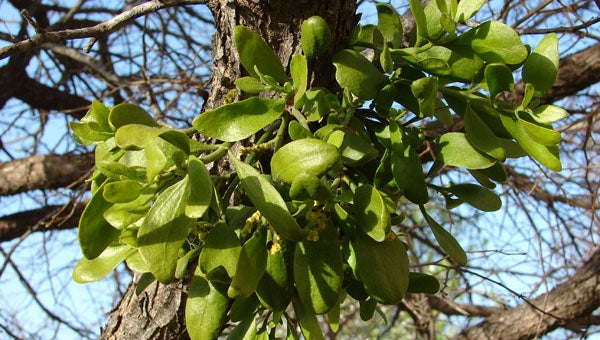Mistletoe, a parasitic plant, lives on trees
Published 11:10 am Monday, December 21, 2015

Mistletoe, known as the plant used in the Christmas kissing tradition, is a parasitic plant. Eastern Mistletoe can be found at Oak Mountain State Park. (Contributed)
By EMILY D. COOK / Community Columnist
Does your family have a Christmas tradition of hanging mistletoe and kissing under it?
No need to hang it here –– Mistletoe is a common plant observed in the canopy of Oak Mountain’s trees.
Mistletoe is the common name of most obligate hemiparasitic (plant is one that derives some or all of its nutritional requirements from another living plant) plants. The plants attach and penetrate the branches of a tree or shrub by a structure called the haustorium (appendage), through which they absorb water and nutrients from the host plant.
Mistletoe is a hemiparasite because it does perform a little photosynthesis for a short period of their life cycle.
Many trees can deal with a small amount of mistletoe by cutting off nutrients to the branch that has the mistletoe, but large infestations of it can kill the host tree.
There are over 900 species of mistletoe plants.
You will find many of those species of mistletoe in subtropical and tropical climates. The Eastern Mistletoe, Phoradendron leucarpum, is native to North America, but we have had at least one species introduced to California, the European Mistletoe, Viscum album.
The European Mistletoe successfully parasitizes more than 200 tree and shrub species.
Here in Oak Mountain, you can find the Eastern Mistletoe living in elms, oaks, maples, dogwood, sweetgum and hickories.
The Eastern Mistletoe has leaves that are short, broad, thick and leathery, with an opposite arrangement.
The berries are white, fairly small and come in clusters of 10 or more.
The European Mistletoe looks similar but the leaves longer oval shaped, and the berries are in clusters of two to six.
A cool feature about how mistletoe is able to disperse to different trees is that their seeds are coated with a sticky material called viscin, which allows the seed to “stick” itself to a stem after a bird transports it to a new location.
Both are used in Christmas traditions of kissing under the mistletoe. Who came up with kissing under a parasitic plant? Hum!
Please remember that you keep Alabama State Parks open by supporting them.








